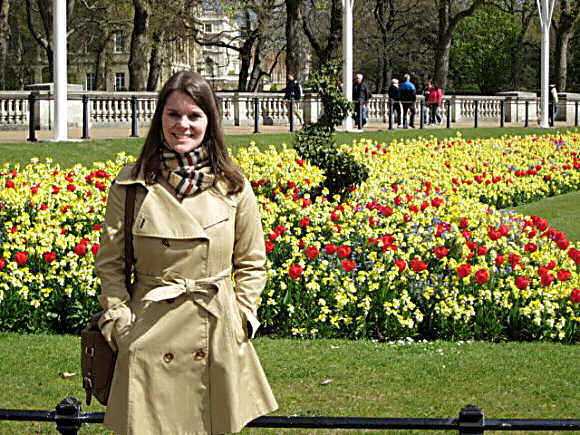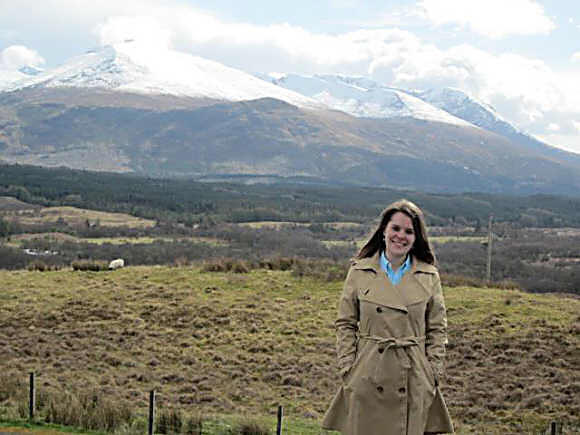|
Edited
by Frank R. Shaw, FSA Scot, Dawsonville, GA, USA
Email:
jurascot@earthlink.net
For a second time, Furman
University senior Erin Frazer is appearing in the pages of Robert Burns
Lives! We first learned of Erin just a few weeks ago in an article
regarding her serving an internship at the Scottish Parliament in Edinburgh.
Now she is back and in grand style, having written an article about Robert
Burns which appears below.
A lot has been said over the
years about young people not being interested in Burns, but in this case I
beg to differ. Recently we had some school children write about their
experience in putting on their own Burns Supper at school around the same
time Erin was enjoying her first Burns Supper which was hosted by the
Scottish Parliament. Both cases prove there is a rekindling of young people
willing learn about and celebrate Scotlandís National Bard. It doesnít
matter that one was celebrated in a school house while the other was
commemorated in one of the most expensive buildings ever built in Scotland.
What matters is that young people of varying ages took time to pay tribute
to Burns.
Erinís paper is part of her
study-abroad program which she is required to submit for college credit. She
is coming back to Furman University in Greenville, SC on May 2, and she has
a standing invitation to come see the Burns collection that Susan and I have
been building for over 15 years. Hopefully, if her time permits, she will
find time to attend one of the meetings of our Burns Club of Atlanta and
present her paper to our membership. What a treat for her and for us!
(FRS: 4.26.12)
Robert Burns: Scotland's
National Bard
Erin Frazer, Senior
Furman University
Greenville, SC, USA

Erin in London outside Buckingham Castle
Robert Burns is known as Scotlandís National
Bard. On the centenary of the poetís birth, Ralph Waldo Emerson stated to
the Boston Burnís Club, ď[Burns] is an exceptional genius. The people who
care nothing for literature and poetry care for BurnsĒ (Emerson). Emersonís
quote speaks to the idea that all Scots can identify with Burnsí poetry and
songs. In his brief life of 37 years, Burns
"left behind him a volume in which
there is inspiration for every fancy, and music for every mood; which lives,
and will live in strength and vigouróto soothe the sorrows of how many a
lover, to inflame the patriotism of how many a soldier, to fan the fires of
how many a genius, to disperse the gloom of solitude, appease the agonies of
pain, encourage virtue, and show vice its ugliness; óa volume, in which,
centuries hence, as now, wherever a Scotsman may wander, he will find the
dearest consolation of his exile" (Lockhart).
Part One: Brief Biography
Early Years
Robert Burns was born on
January 25, 1759 to William and Agnes Burns in the quaint village of Alloway,
Scotland. Robert was the eldest of seven children (Simpson 1). Robert's
parents encouraged his love for song, poetry and writing early on. Burns'
mother taught him about Scots song and his father supported his educational
pursuits (Simpson 1).
As long as his
schooling didn't interfere with his farm chores, Robert was strongly
encouraged to attend ("Robert Burns"). In the beginning, Robert attended
William Campbell's school, and then studied under a private tutor, John
Murdoch (Simpson 2). When Robert turned 7, his family moved to Mount
Oliphant farm. At Mount Oliphant, his family lived sparsely and Robert
toiled away performing intensive labor ("Robert Burns"). While there,
Robert attended the Dalyrymple School every other week. Although he didn't
receive formalized classroom instruction as often, he continued to be an
avid reader.
At age 16,
Robert went back to formal schooling in Kirksowald. When he turned 18, his
father acquired a farm, which allowed Burns to mingle with higher social
classes (Simpson 3-4). When he turned 22, he was sent to Irvine to learn
the trade of flaxdressing. During his training, Richard Brown encouraged
Burns to submit his poem (which he had been writing on the side) for
publication. After speaking with Brown, Burns started working on his
First Commonplace Book (Simpson 5).
Burns' Early Career
By age 27, many
observers considered Burns an "accomplished poet" (Simpson 9). His early
works tended to be about farm life and possessed a satiric edge. After the
birth of his first child out of wedlock, he started to write about the ills
of orthodox Presbyterianism (Whatley).
During this
time, he had romantic complications with Jean Amour. Burns had a form of
civil wedding in Scotland with Jean once she became pregnant.
Unfortunately, Jean's father severely disapproved of Burns and consulted
with the lawyer who drew up the marriage papers to cut Burns' and Jean's
names from the document to effectively annul their marriage (Simpson).
Burns' Edinburgh Career

Erin at Edinburgh Castle
In 1786, Burns left for
Edinburgh. There, he was "welcomed by a circle of wealthy and important
friends" ("Robert Burns"). Among these friends included the Lord Provost,
the Duchess of Gordon, and James, Earl of Glencairn, who became Burns'
patron. Additionally, the Literati, or Edinburgh intellectual circle,
greeted Burns with praise and admiration. One member of the literati, Henry
Mackenize, admonished Burns for writing in Scots. Mackenzie contended that
the preferred language for poetry was English (Simpson). Despite the
influences of his Edinburgh friends, Burns was determined to remain his own
man, and as such, he continued to write his poetry and songs in Scots (as
well as some in English). Burns stated, "I have the advice of some very
judicious friends among the Literati here, but with them I sometimes find it
necessary to claim the privilege of thinking for myself" (Simpson 21). In
1787, one year after he arrived, he left Edinburgh to tour the Scottish
countryside (Simpson 21).
Burns' Later Career
In 1788, Burns married
Jean Armour (again). Jean, Robert and their children moved to Ellisland
farm. There, Burns continued to write poetry and songs as well as tend to
the farm. In 1789, he became an exciseman ("Robert Burns"). In 1793, he
moved his family to Dumfries. While there, Burns authored his famous song
'A Man's a Man for a' That,' which has become a universal anthem for
humankind and draws heavily upon Adam Smith's ideas in his Theory of
Moral Sentiments (Simpson).
The hard work of
Burns' new job, coupled with the hardships of his earlier life and
self-indulgent lifestyle began to take toll on Burns' health. On July 21,
1796, at age 37, Robert Burns died and was "buried with full civil and
military honors on the very day his son Maxwell was born" ("Robert Burns").
After Burns' death, a memorial edition of his poems was published to
provide money for his wife and children ("Robert Burns").
Part Two: Burns' Influences
and his Resulting Literary Works
Burns' Literary Works and
Popular Appeal
There are many
reasons that people from differing backgrounds can identify with Burnsí
works. One reason is because much of the influence for Burnsí songs and
poetry was based on his personal life experiences (MacLachlan). As we know,
Robert Burnsí life experiences ranged from growing up in a tenant-farming
family, to being admonished by the Kirk, to falling in love with multiple
women (MacLachlan). Additionally, the political and cultural surroundings
of his day influenced his work. Burns sympathized with the French
revolutionaries and commemorated the Jacobites from the Battle of Culloden
(Simpson). Burns' works echoed the literary styles of his predecessors,
Allan Ramsay and Robert Fergusson (Ritchie). Literary scholars are in
disagreement over which of these varied influences shaped Burns' work the
most. However, given a careful analysis of Burns' literary works, Burns'
personal life experiences influenced his poems and songs to the greatest
extent.
Farm Life Influences on
Burns' Work

Erin in the Highlands
In concurrence
with the claims of the scholars McGuirk, Simpson, and Whatley, Burns'
experiences growing up in Ayrshire, Scotland, to a tenant farming family
influenced his earlier works a great deal. As a child, Burns learned
first-hand the difficulties of living in poverty. McGuirk (260) contends
that Burns' family struggled at the edge of bankruptcy for most of his
childhood. This personal life experience led Burns to write poems and songs
that "satirize displays of arrogant entitlement" (McGuirk 255). One of his
better-known works that displays this tendency is his poem 'To a Mouse'
(Simpson). This tendency to satirize entitlement, and the class system, is
an undercurrent that can be seen throughout many of Burns' works (Simpson).
An 'Untutored Muse'?
However, the
fact that Burns grew up in a tenant farming family doesn't justify the claim
of some scholars that Robert Burns was uneducated. "Initially, his low birth
and, in particular, his lack of a liberal education were regarded as
disadvantages for which allowance had to be made in criticism" (Sampson
18). In spite of his social status, Burns was in fact well read, had a
private tutor, John Murdoch, when he was young, attended the Dalyrymple
School for a time, and attended formal schooling in Kirksowald at age
sixteen (Simpson). In this light, one is inclined to agree with scholar
David Daiches, who contends, "Burns deliberately exaggerated his lack of
education and played up to the sentimental notion of the natural man"
(Sampson 22). In fact, Simpson believes that Robert Burns constructed the
image of himself as an 'untutored muse' in order to connect with ordinary
Scots in his works (7).
Influences on Burns' Writing
Style
Robert Burns'
personal experience of reading poetry authored by Allan Fergusson and Allan
Ramsay inspired his distinctive literary style (Ritchie). However, Burns
did not, as McLachlan (2006) suggests, simply emulate the works of Ramsay.
Instead, Burns utilized the works of the former Scottish vernacular poets to
create his own works in both the Scots and English language (Ritchie).
Burns built upon Fergusson's works by refining the Standard Habbie Stanza
"so that it came to be used with such brilliant effect" (Ritchie 669).
Burns and the Kirk
In concurrence
with Simpson and Whatley, there is evidence that as Burns matured as a poet,
his works started to reflect his personal life experiences with the Kirk
(Whatley). Burns started to write about religion to comment on what he saw
as the 'ills' of orthodox Presbyterianism (Simpson). This characteristic of
Burns' works first arose when Burns' first child, Bess, was born out of
wedlock. Burns and Elizabeth Paton, Bess' mother, had to appear before
their church congregation as fornicators. This experience led Burns to
write 'A Poet's Welcome to his Love-Begotten Daughter' and the song, 'The
Fornicator: A New Song' (Simpson).
Additionally, as
these scholars suggest, church matters and theological debates inspired
Burns (Whatley). In particular, Burns commented on the practices and
demeanour of the elders of the parish kirk session. An example of the
former is 'The Holy Tulzie'; of the latter the epistle 'To The Rev. John
M'Math', where the poet admits that when confronted by the elders,
"... I gae mad at their
grimaces,
Their sighan, cantan, grace-prood faces,
Their three-mile prayers, an' hauf-mile graces,
Their raxan conscience,
Whase greed, revenge, an' pride disgraces
Waur nor their nonsense." (Whatley 99).
In concurrence
with Kenneth Simpson (2005), throughout Burns' works that centered upon the
Kirk, Burns' beliefs that judgment is the right of God alone and that true
morality is the morality of the heart prevailed as a constant theme
(Simpson). For example, in his poem, 'Holy Willie's Prayer,' Burns comments
on the idea that judgment is the right of God alone in a satirical fashion.
This poem is renowned as one of the greatest texts of the Scottish
Enlightenment (Simpson).
Romantic Interludes which
Shaped Burns' Works
Another one of
Burns' personal life experiences that significantly influenced his works was
his relationships with women (McLachlan). Women ignited Burns' poetic
nature as evidenced by his brief affair with Mary Campbell, who Burns
referred to as 'Highland Mary' (Simpson). His relationship with Mary
motivated him to write the songs 'The Highland Lassie, O' and 'Highland
Mary' (Simpson, 2005). His later relationship with Agnes McLehose in
Edinburgh inspired him to write the song 'Ae Fond Kiss' (Simpson).
Furthermore, Simpson (2005) suggests that Burns associated procreation with
his own poetic creativity. Burns once stated, "Making a poem is like
begetting a son; you cannot know whether you have a wise man or a fool,
until you produce him to the world and try him" (Simpson 19).
Burns' Scottish Travels and
Effects on His Works

Erin in the Highlands
In 1787, Robert
Burns travelled throughout the Scottish countryside touring sites of
historical significance including Bannockburn, Linlithgow, Ossian's grave,
and Culloden. Simpson (2005) contends that it was these personal visits to
sites of historical significance, which allowed Burns to collect images to
write his 'nationalistic' songs. In fact, in 1793, Robert Burns wrote his
friend, George Thomson, a letter with copy of his "Scots Ode" (McGuirk). In
his letter to Thomson, Burns revealed two sources of inspiration for his
work: "a visit to Bannockburn in summer 1793, and glowing thoughts as he
walked the battleground of the revolutions in America and France" (McGuirk
270).
From these
travels, Simpson, Whatley, and McGuirk suggest that Burns began to empathize
with the Jacobites (although he didn't directly support their efforts).
From this empathy, Robert Burns authored 'Lament of Mary Queen of Scots'
(Simpson). I espouse the idea that "Sentimental Jacobitism, a tide of
feeling and current of thought which was recreating Scotland's recent
history, was both drawn on and sustained by Burns, and could and did
flourish--alongside affection for and appreciation of the benefits of
Hanoverian rule" (Whatley 100).
Political Ideology and its
Influence
Burns was not
necessarily a 'radical' political figure. To the contrary, in agreement
with scholar W.J. Murray, Burns consistently held to certain social and
political ideals, and these were the ideals of the democratic French
Revolution of 1793 (Sampson). These democratic ideals inspired
Burns' nationalistic work. J.G. Lockhart states that Burns' poetry revived
and strengthened the national feelings of his Scottish countrymen
(Sampson). Indeed, in Burns' own words, "The appelation of a Scotch Bard is
by far my highest pride; to continue to deserve it is my most exalted
ambition. Scottish themes, and Scottish history are the themes I could wish
to sing" (Simpson 23).
Burns' Legacy
Overall, Robert
Burns' own life experiences had the greatest impact on his literary works.
"[Burns'] true talent lay in turning the everyday speech, songs and stories
of the people he had grown up with into poetry, an communicating to readers
the latent power, eloquence, and nobility of the ordinary man and woman"
(Herman 293).
Works
Cited
Emerson, Ralph Waldo.
"Robert Burns." Miscellanies. Houghton, Mifflin and Company, 1904.
437-443. Rpt. in Literature Criticism from 1400 to 1800.
Ed. James E. Person, Jr. Vol. 3. Detroit: Gale Research, 1986. Literature
Resource Center. Web. 12 Mar. 2012.
Herman, Arthur. How the
Scots Invented the Modern World: The True Story of How Western Europe's
Poorest Nation Created Our World & Everything in It. New York: Crown,
2001. Print.
Lockhart, John Gibson. "Life
of Robert Burns." Life of Robert Burns. J. M. Dent & Sons, 1907.
322. Rpt. in Poetry Criticism. Ed. Drew Kalasky. Vol. 6. Detroit:
Gale Research, 1993. Literature Resource Center. Web. 10
Mar. 2012.
McLachlan, C.
"Burns and Ramsay." Scottish Studies Review 7.2 (2006): 9-23.
Academic Search Premier, EBSCOhost. Web. 1 Apr. 2012.
McGuirk, Carol. "Jacobite
History to National Song: Robert Burns and Carolina Oliphant (Baroness
Nairne)." The Eighteenth Century 47.2 (2006): 253-87. Print.
Ritchie, Daniel. "The Bard:
Robert Burns, A Biography." Christianity and Literature 60.4 (2011):
668-71. Academic Search Premier, EBSCOhost. Web. 10 Mar. 2012.
"Robert Burns." BBC News.
BBC, 2012. Web. Mar.-Apr. 2012. <http://www.bbc.co.uk/arts/robertburns/biography/>.
Sampson, D. "Robert Burns:
The Revival of Scottish Literature." Modern Language Review 80.1
(1985): 16-18. Academic Search Premier, EBSCOhost. Web.
11 Mar. 2012.
Simpson, Kenneth. Robert
Burns. Grantown-on-Spey, Scotland: Colin Baxter Photography, 2005.
Print.
Whatley, C. "Burns: Work,
Kirk and Community in Later Eighteenth-Century Scotland." Poetry
Criticism. By Michelle Lee. Detroit, MI: Gale, 2012. 92-115. Print. |

